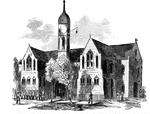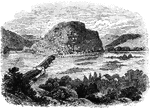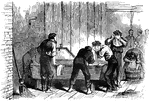The 1861-1865 Civil War Places ClipArt gallery offers 187 illustrations of places that are famous due to battles or other events during the American Civil War.

Fort Lafayette
Fort Lafayette was an island coastal fortification in New York Harbor, built next to Fort Hamilton.…

Fort Macon
"Surrender of Fort Macon, GA., April 26th, 1862. Exterior on side facing the Federal Batteries, showing…

Fort Norfolk
"Old Fort Norfolk, built by the Federal government, but altered and strengthened by the Confederates."…

Fort Runyon
"Section of Fort Runyon, Va., guarding the road to Alexandria, occupied by the Twenty-first Regiment,…

Fort Sumter
The fort is best known as the site where the shots initiating the American Civil War were fired, at…
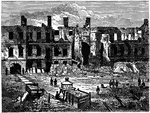
Inside the Walls of Fort Sumter
The fort is best known as the site where the shots initiating the American Civil War were fired, at…

Fort Sumter in 1864
The fort is best known as the site where the shots initiating the American Civil War were fired, at…
Fort Taylor
"Fort Taylor, Key West, Fla. Key West, the most western of the Pine Islands, is about sixty miles southwest…

Fort Taylor, Key West
Fort Taylor was built in 1845 in Key West, Florida and used in the American Civil War.

Fort Thompson
"Bombardment and capture of Fort Thompson, thirteen guns, near New Berne, on the Neuse River, by the…
Fort Vulcan
"Fort Vulcan, Jones's Island, Savannah River, Ga.- one of the Federal batteries cutting off communication…

Fort Washington
Fort Washington was the only defense that the capital had at the beginning of the Civil War.

Front Royal
"Front Royal, Manassas Gap Railroad, Blue Ridge Mountains in the distance- the Federal army entering…

Scene of the Battle of Gaines' Mill
Mill, with a man standing and a man on horseback in the foreground.

Headquarters of General Butterfield
"Headquarters of General Butterfield, near Harrison's Landing, James River, Va." —Leslie, 1896
General Hospital Exterior
"United States General Hospital, Hilton Head, S. C., exterior. The United States General Hospital at…

General Hospital Interior
"United States General Hospital, Hilton Head, S. C., interior. The United States General Hospital at…
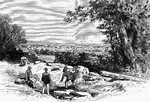
Battlefield of Gettysburg
"The battlefield of Gettysburg- breastworks, Culp's Hill- Gettysburg in the distance."— Frank…
Government Buildings - Contraband Camp
"Government buildings for 'Contrabands,' erected at Hilton Head, S. C., in 1862. Among the many singular…

View of Grafton
"View of Grafton, West Virginia, occupied by the Federal Troops, under the command of General McClellan,…

Grafton Occupied by Federal Troops
"View of Grafton, West Virginia, occupied by the Federal Troops, under the command of General McClellan,…

Railroad at Grafton
"View of Grafton, West Virginia, occupied by the Federal Troops, under the command of General McClellan,…
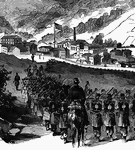
Federal Troops at Grafton, West Virginia
"View of Grafton, West Virginia, occupied by the Federal Troops, under the command of General McClellan,…

Great Bakery
"The Great Bakery for the United States Army at the Capitol, Washington, D. C.- sketched by our special…

View of Harper's Ferry, 1862, Looking South
The town of Harper's Ferry, where an important Civil War battle was fought in 1862.

Burning of the Arsenal at Harper's Ferry
The burning of the arsenal in Harper's Ferry during the American Civil War

Harrison Mansion
"The old Harrison Mansion, Harrison's Landing, Va., the birthplace of President William Henry Harrison,…

Harrison's Landing
"Harrison's Landing, James River, Va. The commissariat depot and base of operations of General McClellan…

Fort Hatteras
View of the camp of the twentieth Indiana Regiment; also of Fort Hatteras and the anchorage at Hatteras…

Hilton Head
"Exterior view of fortifications erected by the Federal troops at Hilton Head, Port Royal. S. C. Hilton…
Hilton Head
"Expedition to Port Royal- Government buildings erected on Hilton Head, S. C., by the Federal forces…

Hilton Head
"Expedition to Port Royal- Government buildings erected on Hilton Head, S. C., by the Federal forces…
Hooker's Headquarters
"General Hooker's headquarters at Chancellorville, May 1st."— Frank Leslie, 1896

Hospital
"The war in Virginia--hospital scene after the Battle of Bristoe Station."— Frank Leslie, 1896
Hundred Mile Prairie
"Camp life in the West. During one of the pauses in the active part of the Missouri campaign our special…

Island Number Ten
Island Number Ten was a former island in the Mississippi River near Tiptonville, Tennessee and the site…

Bombardment of Island Number Ten
Island Number Ten was a former island in the Mississippi River near Tiptonville, Tennessee and the site…

Tybee Island
"Tybee Island, Savannah River, Ga.- Views of the lighthouse and barracks- destruction of the lighthouse…

Iuka Springs, 1862
The Battle of Iuka was an American Civil War battle fought on September 19, 1862, in Iuka, Mississippi.

Jackson Hill
"Sheridan's campaign in the valley of the Shenandoah- view of the front from the Federal lines on Jackson…

Jefferson City, Missouri
"Jefferson City, capital of Missouri. The arrival of General Fremont's division, September 26th, 1861.…
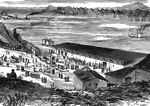
Jefferson City Railroad Depot
"Jefferson City, capital of Missouri. The arrival of General Fremont's division, September 26th, 1861.…

Jefferson City Capitol Building
"Jefferson City, capital of Missouri. The arrival of General Fremont's division, September 26th, 1861.…
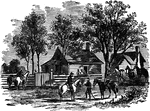
Place of Johnston's Surrender to Sherman
The place where Johnston surrendered to Sherman in the American Civil War.
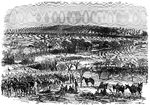
Kelley's Ford
"Kelley's Ford, on the Rappahannock, the scene of the Battle of the 17th of March, and of General Stoneman's…

View of Kenesaw from Pine Mountain
Kennesaw Mountain was the site of the Battle of Kennesaw Mountain during the 1864 Atlanta Campaign of…
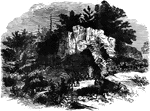
Killing's Cave
"Killing's Cave, on the banks of the Potomac, near Sharpsburg, the place of refuge of many citizens…

Lafayette Parish
"The war in Louisiana- General Franklin's army crossing the prairie in Lafayette Parish, November 16th,…

Lake Providence
"Lake Providence, La., headquarters of General McPherson and the Federal division under his command.…

Interior of Libby Prison
"Interior of Libby Prison, Richmond, Va., with prisoners from General Lee's army confined after the…



